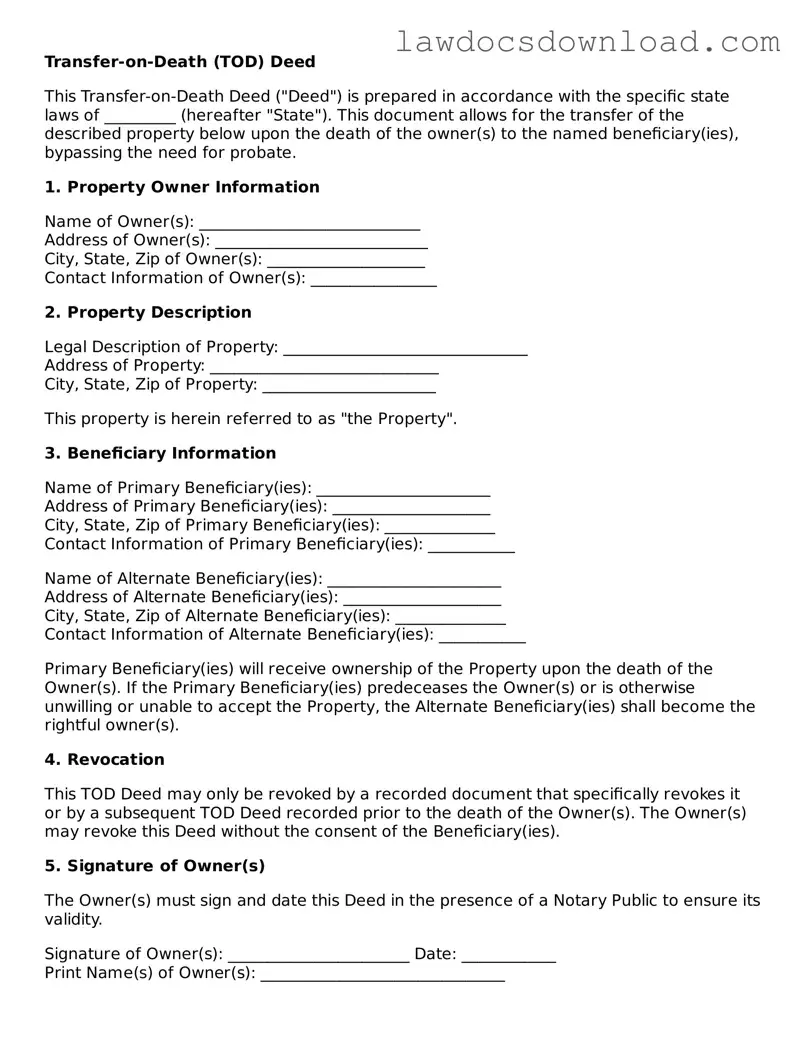Transfer-on-Death (TOD) Deed
This Transfer-on-Death Deed ("Deed") is prepared in accordance with the specific state laws of _________ (hereafter "State"). This document allows for the transfer of the described property below upon the death of the owner(s) to the named beneficiary(ies), bypassing the need for probate.
1. Property Owner Information
Name of Owner(s): ____________________________
Address of Owner(s): ___________________________
City, State, Zip of Owner(s): ____________________
Contact Information of Owner(s): ________________
2. Property Description
Legal Description of Property: _______________________________
Address of Property: _____________________________
City, State, Zip of Property: ______________________
This property is herein referred to as "the Property".
3. Beneficiary Information
Name of Primary Beneficiary(ies): ______________________
Address of Primary Beneficiary(ies): ____________________
City, State, Zip of Primary Beneficiary(ies): ______________
Contact Information of Primary Beneficiary(ies): ___________
Name of Alternate Beneficiary(ies): ______________________
Address of Alternate Beneficiary(ies): ____________________
City, State, Zip of Alternate Beneficiary(ies): ______________
Contact Information of Alternate Beneficiary(ies): ___________
Primary Beneficiary(ies) will receive ownership of the Property upon the death of the Owner(s). If the Primary Beneficiary(ies) predeceases the Owner(s) or is otherwise unwilling or unable to accept the Property, the Alternate Beneficiary(ies) shall become the rightful owner(s).
4. Revocation
This TOD Deed may only be revoked by a recorded document that specifically revokes it or by a subsequent TOD Deed recorded prior to the death of the Owner(s). The Owner(s) may revoke this Deed without the consent of the Beneficiary(ies).
5. Signature of Owner(s)
The Owner(s) must sign and date this Deed in the presence of a Notary Public to ensure its validity.
Signature of Owner(s): _______________________ Date: ____________
Print Name(s) of Owner(s): _______________________________
This document was signed and acknowledged before me on this __ day of ___________, 20__, by ___________________________, known to me (or satisfactorily proven) to be the person(s) whose name(s) is/are subscribed to the within instrument.
Notary Public Signature: _________________________
Printed Name: ___________________________________
My commission expires: ___________________
6. Recording
To be effective, this Deed must be recorded with the county recorder’s office in the county where the Property is located before the death of the Owner(s).
It is strongly recommended to consult a legal professional before executing this Deed to ensure compliance with current state law and understand its full implications.
